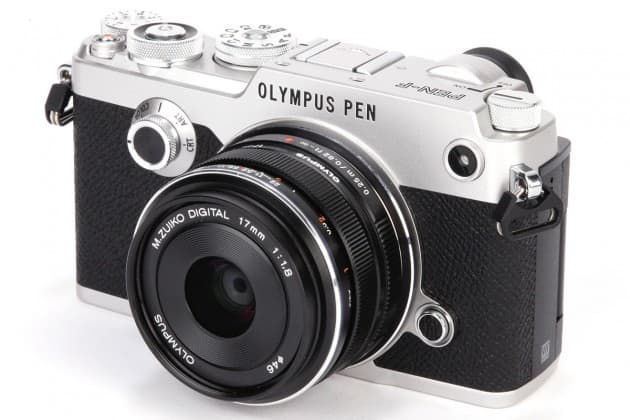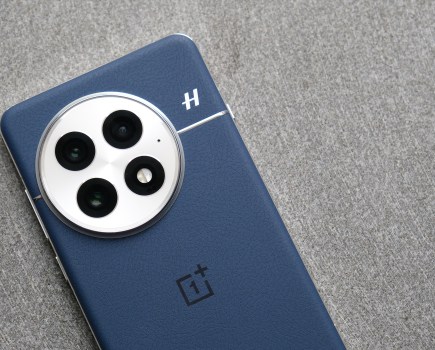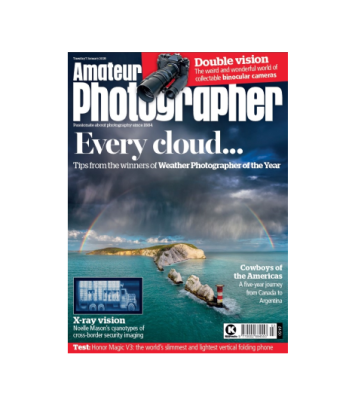Olympus PEN-F review: Hands-on First Look
This is an archived version of our original hands-on first look article about the PEN-F, with additional images

The pretty, retro-styled PEN F will be available in silver, or all-black
At a glance:
- 20-million-pixel Four Thirds sensor
- ISO 80-25600 (extended)
- 2.36-million-dot OLED EVF (0.62x magnification)
- 1.04-million-dot 3in fully articulated touchscreen
- 5-axis in-body image stabilisation
- 50-million-pixel high-resolution composite mode
- £999.99 body only, £1,099.99 with 14-42mm lens, £1,199.99 with 17mm f/1.8 lens
When Olympus launched its first Micro Four Thirds camera, the PEN E-P1 back in 2009, it made great play of its heritage harking back to the legendary PEN-F half-frame 35mm SLR. But with its latest mirrorless model it’s gone a step further, not only appropriating more of its predecessor’s 1950s design cues, but also its name. Meet the oh-so-pretty PEN-F: Olympus’s first flat-bodied compact system camera to include a built-in viewfinder.
However, that’s not the PEN-F’s only point of interest. It’s also the first Olympus Micro Four Thirds camera to feature a 20-million-pixel sensor, which does without an optical low-pass filter to maximise resolution. It’s likely to be the same sensor as Panasonic uses in the GX8 and, if so, we can expect to see small but welcome improvements in overall image quality compared to Olympus’s previous models – not just in resolution, but also dynamic range and high ISO noise.

The PEN-F sits alongside the SLR-like OM-D E-M5 II in Olympus’s range
According to Olympus, the PEN-F isn’t a replacement for the three-year-old E-P5, despite being part of the same family of cameras. Instead it’s positioned as a new higher-end model, which sits alongside the SLR-like OM-D E-M5 II in the range, offering a different set of strengths and weaknesses. With a body-only price a penny short of £1,000, it’s very much a premium camera.
Despite its name, the PEN-F bears little resemblance to its rather minimalist forebear. Instead, it looks strikingly like a digital reincarnation of the iconic Leica III 35mm rangefinder. It has top-and front-plate dials in many of the same places, although, as might be expected, they perform rather different functions. To me, the likeness seems too strong to be merely a coincidence, but I’m not complaining because, frankly, the PEN-F looks gorgeous.
Features

The PEN-F is the first Olympus camera with a 20-million-pixel Four Thirds sensor
Lurking behind the PEN-F’s nostalgic exterior is a very up-to-date camera. The 20-million-pixel sensor and TruePic VII processor combine to offer a standard sensitivity range of ISO 200 to 25,600, with a pulled ISO 80-equivalent LOW setting for bright light shooting. The mechanical shutter offers speeds from 1/8000sec to 60 seconds, and a silent electronic shutter option giving an even faster 1/16000sec maximum.
Continuous shooting is available at up to 10 frames per second, or 5 frames per second with autofocus between frames, and with a 16-frame buffer when shooting in raw. Autofocus uses an 81-point contrast detection system, and spot metering can now be linked to the AF point.

The shutter button is threaded for a mechanical cable release
One of Olympus’s key features is its in-body image stabilisation, and the PEN-F includes essentially the same 5-axis system as the E-M5 II. Said to offer fully five stops of stabilisation according to CIPA standard testing, in my experience it’s one of the very best stabilisation systems currently available, being uncannily effective for both stills and video shooting.
Olympus has also included its high-resolution composite mode, again previously seen on the E-M5 II. This takes eight exposures and combines them into a single image, now with a 50-million-pixel resolution. However the camera needs to be mounted on a tripod and the subject has to remain static during the process for good results.

The PEN-F will ship with the same clip-on flash as the OM-D E-M5 II
There’s no built-in flash, but the PEN-F will ship with the same small FL-LM3 flash unit as the OM-D E-M5 II, which slots onto the hotshoe and draws its power from the camera. With its bounce-and-swivel head and ability to act as a wireless controller for off-camera units, it’s the most useful miniature external flash of its type.
A fairly conventional-looking video spec is included, with Full HD recording at up to 60fps and built-in stereo microphones. Less common options include slow-and fast-motion recording, the ability to specify fixed-length clips, and a few unusual image-processing effects. It’s also possible to create time-lapse movies at 4K resolution.
Build and handling

The power switch resembles a 1950s film rewind knob
When you pick up the PEN-F, you’ll find that the build quality reflects its premium price. The body shell is predominantly aluminium, making it feel solid in your hands, and all the dials are milled rather than cast, giving a precision, tactile feel. The camera’s retro credentials are reinforced by the power switch, which resembles a film rewind knob, and the shutter button, which is threaded for a good old-fashioned cable release. Unlike Olympus’s high-end OM-Ds, though, the PEN-F isn’t described as weathersealed.
In terms of controls and handling, the PEN-F is something of a departure from recent Olympus designs. It’s the first of the company’s Micro Four Thirds models to sport a dedicated exposure compensation dial, covering +/-3EV in 1/3EV steps. This is positioned for easy operation by your thumb, and has click stops that feel solid enough to prevent inadvertent movement. Twin electronic dials, front and rear, control shutter speed and aperture, but can be reconfigured to set ISO, white balance or flash compensation if preferred.

The PEN-F is Olympus’s first Micro Four Thirds model with an exposure compensation dial
The exposure mode dial has a toggle lock button, and gains four numbered ‘C’ positions for saving and recalling user-defined set-ups, replacing Olympus’s menu-based ‘Myset’ setups. Users who miss scene modes and Olympus’s Photo Story mode can assign them to C4 and C3 respectively.
Also gone is the confusing ‘2×2’ control system first seen on the PEN E-P5, whereby a switch on the camera’s back changed the mode of the dials to controlling ISO and white balance. Instead – much more sensibly – pressing the ‘up’ key on the d-pad has the same effect. The cumulative effect of these changes is that, at first sight, the PEN-F promises to have the best control layout of any recent Olympus camera.
Image processing controls

A front-plate dial gives quick access to in-camera processing settings
Olympus has long played up how electronic viewfinders are good for previewing images before they’re taken, and on the PEN-F it’s brought to the fore, giving easier access to image processing settings and displaying them live in the EVF. A new dial on the front-plate, positioned in the same place as the film Pen F’s (and Leica III’s) shutter-speed dial, gives access to the camera’s image processing settings.
Alongside Olympus’s familiar Art Filters and Colour Creator mode are two new options. Monochrome Profile Control allows you to mimic the effects of using coloured lens filters with black & white film, manipulate contrast and add vignetting. Meanwhile the Colour Profile Control mode allows you to selectively emphasise different hues in the image as you choose, for example, accentuating blues and suppressing reds.

Colour processing can be adjusted using this onscreen graphic interface
Settings are changed using a new lever control beneath the mode dial in combination with the electronic control dials, and crucially everything is previewed in the viewfinder in real time. If you shoot raw all the time, this probably sounds a bit gimmicky, but it’s great if you like to manipulate the look of your images in-camera before shooting. Fortunately one of Olympus’s great strengths is the attractiveness of its JPEG processing, and you can, of course, record raw files at the same time.
Viewfinder and screen

The 2.36-million-dot EVF is a first for Olympus’s PEN series
Impressively, Olympus has managed to fit an electronic viewfinder into a body that, at 124.8 x 72.1 x 37.3 mm, is barely larger than the original E-P1 (although it’s substantially heavier, weighing 427g). The EVF uses a 2.36-million-dot OLED panel with 0.62x magnification, which means it matches the OM-D E-M10 II for size and detail. However it’s noticeably smaller than the superb viewfinder in the OM-D E-M5 II, which is the price you pay for losing the viewfinder ‘hump’.
Unlike most ‘rangefinder-style’ CSCs, the viewfinder isn’t placed in the extreme corner of the body, but slightly inwards, and it has a large circular eyecup that will hopefully make it less prone to glare from peripheral light. There’s an eye sensor for auto switchover with the LCD, and built-in dioptre correction.

The 3″ touchcreen is fully articulated
The viewfinder brightness adapts in line with the ambient lighting levels, and you can either use the EVF to give a preview of the shot you’re going to get, including the camera’s image processing settings, or to show a perceptually accurate view of the scene using Olympus’s ‘simulated optical viewfinder’ mode.
The rear screen is similar to the E-M5 II’s, being a 3in fully articulated touchscreen. This is an improvement over the tilting screen found in the E-P5, as it’s more suitable for shooting in portrait format. The focus point can be repositioned using the touchscreen, both when viewing with the LCD and with the eye-level viewfinder, although left-eyed users may find themselves inadvertently moving it with their nose.
Accessories

An accessory grip will be available with an Arca Swiss release plate
It’s probably no surprise to see that such a design-conscious camera will be complemented by a range of matched (and expensive) accessories. At launch there’ll be the CSS-S120L leather neckstrap for £79.99, the CBG-11PR leather messenger bag for £379.99, and the CS-47B leather body jacket for £49.99. For the more practically inclined, the £109.99 ECG-4 handgrip includes an Arca-Swiss pattern tripod quick-release base.
First impressions

WDC’s Michael Topham gets hands-on with the Olympus PEN-F
With cameras like this that pay so much attention to style, it can be all too easy to get distracted from the underlying substance. But this would be a mistake, as the PEN-F looks like a very interesting design. With its new sensor, it promises to deliver the best image quality we’ve yet seen from any Olympus camera, and I suspect it might have the best handling while shooting, too.
Olympus sees the PEN-F as a discreet camera that’s ideal for street shooting, and better suited to use with small, fast primes than with large f/2.8 zooms. We’ll test this out, and much more, when we get a review sample – look out for our full assessment in the next couple of months.







